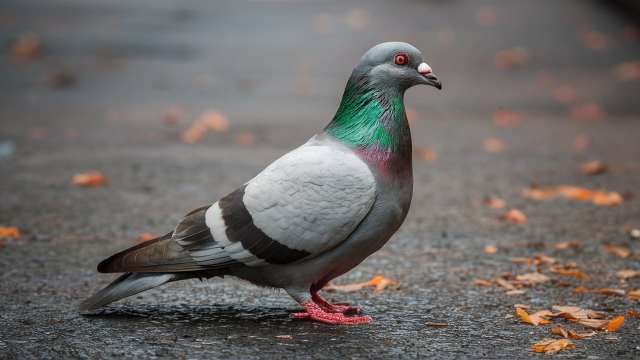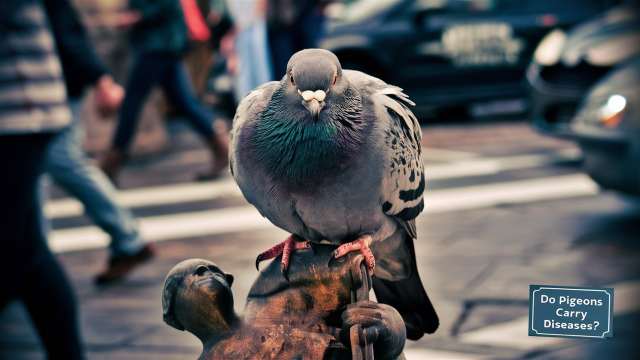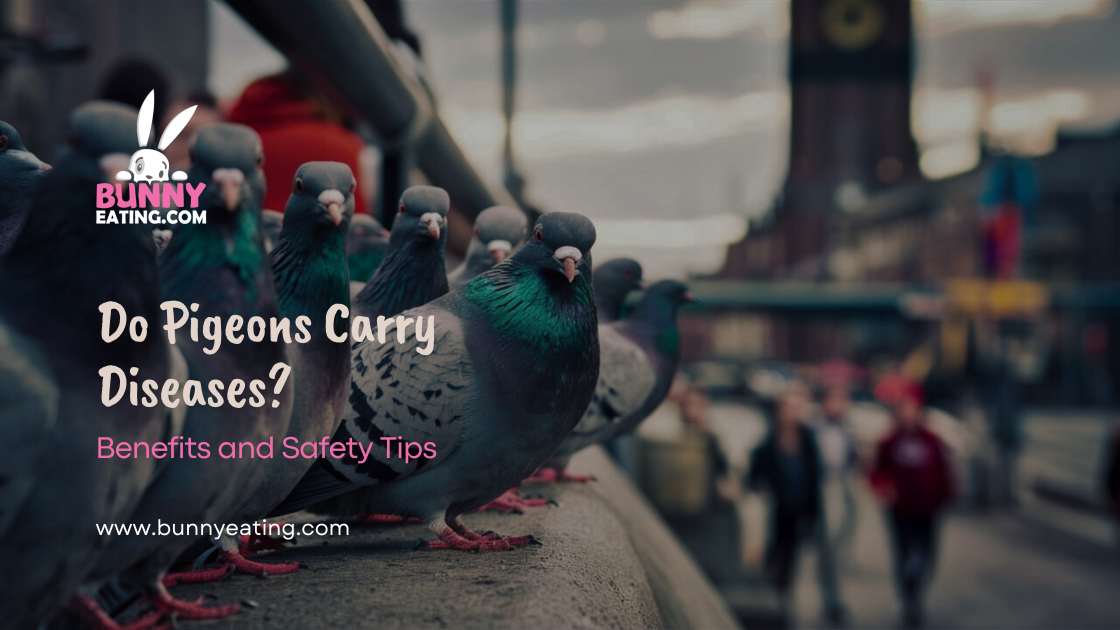Transmitting human and animal diseases, pigeons do a great job. Their droppings are common ways of transmitting these diseases, as well as their feathers and parasitic infections. Some serious diseases may be attributed to these factors; hence it is vital to know what one is getting into before approaching them. Do Pigeons Carry Diseases?
Once upon a time in this busy city, there lived a group of pigeons that everyone knew so well. These birds roamed around the gutters, raided people’s food as they sat out to take some sun, perched happily on the parapets of buildings and cooed incessantly to each other about how nice it was to be alive. It was hard to believe that among them were one or two carriers of dangerous germs and viruses caused by bacteria. Apart from a sneezy boost, other ailments can be caused by pigeons too. So when you see them next time look out!
Various ailments such as histoplasmosis, cryptococcosis and psittacosis are commonly carried by pigeons. Such diseases are capable of infecting human beings via direct interaction or by inhaling the particles of dirt stained with pigeon excrement.
Can Pigeons Carry Diseases?
The short answer is yes, pigeons can indeed carry diseases. But before you start eyeing every feathered friend with suspicion, let’s dig a little deeper. Feral pigeons, those wild city dwellers, are particularly prone to harbouring various infectious diseases. It’s not that they’re out to get us, but their lifestyle and habits make them perfect carriers for certain pathogens.
Feral pigeons have made cities their habitat since time immemorial and thus stick around to town folks’ homes. As a result this sometimes may cause the transfer of diseases. Though every pigeon is not a menace to health in itself; still getting a better understanding of the risks they pose can facilitate safer cohabitation with these common feathered friends.
What diseases do pigeons carry?
Pigeons are known to carry a smorgasbord of diseases, some of which can be quite serious. Histoplasmosis, a fungal infection that affects the lungs, is one of the more common ailments associated with pigeons. Then there’s Candidiasis, which can cause issues in various parts of the body, from the mouth to the digestive tract.
Salmonellosis, our old foe food poisoning, is another disease that pigeons can spread. And let’s not forget about St Louis encephalitis, a mosquito-borne virus that pigeons can help circulate. These are just a few examples of the potential health risks our feathered friends might pose.
Can you get sick from pigeons?
Before you reach for that hazmat suit to put on every single time you leave the house, calm down for a minute. Getting sick from pigeons does happen, but it’s not certain. The danger becomes greater when someone is in constant and close contact with a flock of birds and their droppings. A weak immune system can also make one more susceptible to this type of sickness.
Consider the case of John from New York, who developed a respiratory infection after cleaning out his pigeon-infested attic without proper protection. Or Sarah from Chicago, who contracted Cryptococcus after unknowingly disturbing dried pigeon droppings in an abandoned building. These real-life examples show that while rare, pigeon-related illnesses do happen.

Are pigeon droppings dangerous?
You might think those little white splatters are just a nuisance for your car, but pigeon droppings can be more dangerous than you’d expect. Fresh droppings are less of a concern, but as they dry, they can become a breeding ground for harmful fungi and bacteria.
Asthma as well as other diseases in humans begins with inhaling the airborne spores from dried-up feces. The pathogen that causes ornithosis, which affects people, is present in pigeon droppings. Consequences may result simply from stepping on such remnants; similarly, close-up inhaling of older upper-tract waste products can lead to adverse effects.
How Do Pigeons Spread Disease?
Pigeons aren’t scheming to infect us, but naturally, they are a means through which diseases can be spread. Its droppings, feathers and even the nests may represent virus reservoirs. When such things get dry they can easily be airborne and hence inhaled by human beings.
Another way pigeons spread disease is through contaminated food and water. If a pigeon with Salmonella decides to take a dip in a public fountain or snack from an open food container, it could potentially spread the bacteria. It’s a bit like a very unfortunate game of tag, with microorganisms as the “it.”
How do pigeons spread disease?
Let’s break it down further. Pigeons can spread diseases through direct contact, their droppings, or indirectly through parasites. Ectoparasites like bed bugs, chicken mites, and yellow mealworms can hitch a ride on pigeons and potentially transfer to humans or our living spaces.
Additionally, pigeons are involved in the transmission of ectoparasite illnesses. A prime example is the West Nile virus, which has pigeons as its moderate hosts, and when mosquitoes bite them eventually discover humans who suffer from this disease. This transmission shows how interrelated urban ecosystems are.
Can pigeons spread diseases to humans?
It is correct that pigeons can spread diseases to humans, but this relates more to other factors than direct contact (i.e. through their wings/hands). It is hard that you would get something when you only touch a pigeon. In such cases, however, some agents may contribute to the spread, one of which involves contact with bird droppings or inhaling dust particles containing faecal matter from them.
High-risk scenarios include cleaning out areas with heavy pigeon infestations, like attics or abandoned buildings, without proper protection. If you’re planning on channelling your inner DIY spirit to clear out a pigeon-populated space, make sure to wear a mask, gloves, and protective clothing. And maybe consider calling in the professionals – sometimes, it’s worth leaving it to the experts.
Are Pigeons the Most Disease-ridden Birds?
Even if pigeons always seem to possess an unjust reputation, a balancing perspective is needed. Certainly, they could spread some illnesses but so do numerous other bird species. However, compared to other avian species, pigeons are more associated with cities and thus very social with people who live there leading to high possibilities of coming into contact with them and finally exchanging germs with them as well.
Compared to other urban birds, pigeons do tend to carry a higher number of pathogens. However, this doesn’t necessarily mean they’re the most dangerous. Factors like population density, habitat overlap with humans, and feeding habits all play a role in determining the actual risk of disease transmission.

Are pigeons the most disease-ridden birds?
To answer this, let’s look at some numbers. A study by the British Pest Control Association found that up to 49% of feral pigeons could carry infectious diseases transmissible to humans. That’s a pretty high number, but it’s important to remember that carrying a disease doesn’t always mean transmitting it.
Yet the situation becomes more complicated when one compares pigeons with other birds. For example, waterfowl such as ducks and geese can be carriers of avian influenza viruses that pose a more immediate threat to human beings. Nevertheless, one possibly feels that there is a greater overall risk as pigeons are in much greater proximity to us daily.
Do You Have a Pigeon Problem?
So, how do you know if you’ve got a pigeon problem on your hands? Look out for signs like excessive droppings, nesting materials, or the constant sound of cooing. If you’re seeing pigeons regularly congregating on your property, it might be time to take action.
Exposure to diseases related to pigeons may be increased by living close to a large number of pigeons. This shouldn’t make you sleepless, but is something to think about and take care of. Always remember that if it’s a bird flu thing then prevention is always better than cure.
How to get rid of pigeons
If you’ve chosen to say goodbye to the birds that live close to your house, there are many gentle ways you can do it. Begin with basic approaches such as using shiny materials or installing water sprinklers that operate by motion sensors. Also, think about blocking places where they might build their nests and eliminating options for feeding them.
In cases of persistent issues, it is advisable to install bird spikes or use netting in certain areas. These physical barriers effectively deter the pigeons without harming them. If nothing else seems to work, then you may have to summon bird pest control professionals from the pest management sector. They will offer advanced alternatives appropriate to your unique circumstances.

Conclusion
Pigeons are often seen as a part of the city lifestyle. Many people associate them with dirty places and poor conditions. However, some individuals have chosen to keep them. Their presence is often felt among the most prominent buildings where they find shelter or food. Pigeons also spread several diseases that are dangerous to humans.
Such diseases are transmitted through the droppings or feathers of these birds and sometimes even the parasites they carry along with them. Therefore, we must remain cautious so as not to put ourselves at risk especially when in the nearby areas where these birds roam.
This is to keep away from the birds and their poop. Wash your hands immediately after being around them. For homes which have them, be careful with their faeces and wear protective clothes. It is safer to know that pigeons can carry illnesses. If you want to be free of worries concerning health issues that may arise, just take a few steps to avoid them.
FAQs
Can pigeons spread diseases to humans?
Yes, pigeons can spread diseases to humans through their droppings, feathers, and parasites.
Are pigeons safe to touch?
It’s best to avoid touching pigeons, as they can carry diseases that may infect humans.
Do pigeon feathers carry diseases?
Yes, pigeon feathers can carry diseases, especially if contaminated with droppings or parasites.
Is it bad to catch a pigeon?
Catching a pigeon can expose you to diseases, so it’s not safe to do so.

Admin – Pet Expert shares valuable tips on pet care, nutrition, and health, offering practical advice to help your furry friends thrive.











